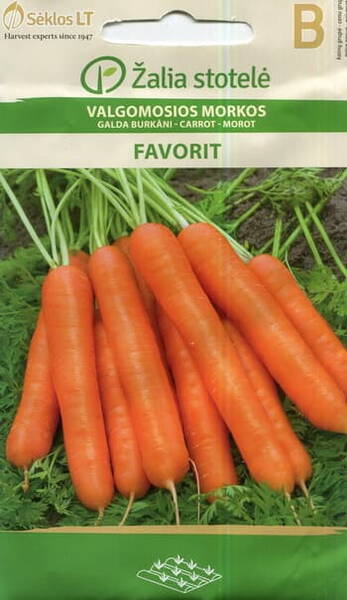A late, very fertile Nantes-type kind. The vegetation period is 140-150 days. The root vegetable is bright orange, grow up to 16-18 cm long, juicy. While growing, the root vegetable does not come to the surface and doesn’t green. This variety is suitable for mechanical crop harvest. Suitable for fresh consumption, processing and storage through winter. Grows best in cultivated, humus, not soaked, light clay loam or sandy loam soils.
* For sowing carrots, use fresh seeds, as they retain good germination for no more than two years. Therefore, it makes no sense to harvest seeds in large quantities.
Prepare the seeds before planting. Since they germinate very slowly, do this well in advance.
There are several ways to prepare seeds for sowing:
Method 1. Carefully pour all the seeds into a plate and pour water into it. Stir lightly with your fingers. Remove any seeds that float to the surface. For some reason, they turned out to be empty, so they are not suitable for sowing. Wrap the remaining carrot seeds in gauze and immerse them overnight in a weak solution of potassium permanganate. This must be done to disinfect them. In the morning, remove the seeds from the solution and lightly wring out the gauze. Take a shallow plate and pour some warm water into it to cover the bottom. Put the seed bundle on this plate and place it closer to the radiator or heater. In this case, they will germinate much faster. Germinated seeds are ready for sowing in the ground.
Method 2. A few days before sowing, prepare a nutritious seed coat. To do this, mix the soil-nutrient mixture, consisting of equal proportions of peat and humus, with a glass of liquid mullein. Pour the seeds into a jar and, shaking it, gradually add the resulting mixture. Shake the jar for a minute. During this time, the seeds will be covered with a nutrient shell. Then pour them out on paper and dry them. When the seeds dry, they will be quite ready for sowing in the ground.
Method 3. Prepare salt water at the rate of 2 tablespoons of salt per 1 litre of water. Pour the seeds into this water. You can safely discard the floating seeds, as they will not sprout. And the seeds that have settled to the bottom, carefully place in a gauze bag and tie it. Rinse the seeds directly through the gauze under running warm water. After that, immerse the seed bag first in hot water for 10-15 minutes, and then for the same time in cold water. After such hardening, untie the bag and scatter the seeds in a thin layer on a damp cloth. Cover and leave on the counter at room temperature for about a day. After germination, the seeds are ready for sowing in the ground.
Method 4. To get seedlings already 4-5 days after sowing, use this method. It may seem too simple to some, but, as you know, everything ingenious is simple! Place dry carrot seeds in a cloth bag and bury in the area to the depth of a shovel bayonet directly into the damp and cold ground. Leave some kind of mark at this place so that later the search for seeds does not turn into the work of digging the entire site. When you decide to sow the seeds, simply dig them out, lay them out on a dry cloth and dry them in the fresh air. After that, sow the seeds in the usual way.
* Ash.
Ash is a valuable fertilizer, especially obtained from tree species. It contains all the nutrients the plant needs, with the exception of nitrogen. The presence in the ash of a large amount of potassium (6-10%), phosphorus (2-4%), calcium carbonate (up to 30%) and trace elements, incl. boron, manganese, molybdenum, zinc, copper, makes it especially valuable for beets, potatoes, carrots and other crops.
Dry ash does not lose its properties during storage for many years. When soaking, the ash loses almost all of its potassium. There is almost no chlorine in the ash - an element harmful to microorganisms and plants, therefore it is useful to use it for chlorine-sensitive crops: potatoes, strawberries and raspberries.
Due to the presence of a large amount of potassium and calcium carbonate, it is mainly used as a potash fertilizer and to neutralize excess soil acidity.















